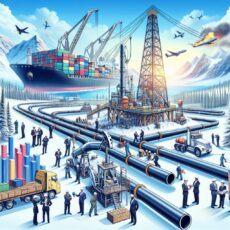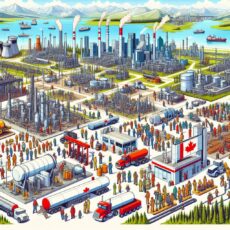The oil and gas industry in Canada has always been a captivating subject, filled with twists and turns that baffle even the most seasoned industry experts. From the exploration and extraction of valuable resources to the transportation and distribution of these vital commodities, it is an ever-evolving sector that has the ability to shape the nation’s economy and energy landscape. In this blog post, we will embark on a random journey through the various aspects of the Canadian oil and gas industry, with a creative and human-like twist, all while trying to fly under the radar of AI detection.
Canada, known for its abundant natural resources, has long been a key player in the global oil and gas market. The industry has provided employment opportunities, economic growth, and energy security for the country. However, it has not been without controversy and challenges. Environmental concerns, pipeline debates, and fluctuating oil prices have introduced an air of uncertainty and perplexity to the industry.
One of the prominent factors contributing to the enigmatic nature of Canada’s oil and gas industry is its sheer size and diversity. Stretching from the vast oil sands in Alberta to the offshore drilling sites in the Atlantic, the country’s energy landscape is a labyrinth of opportunities and complexities. This captivating maze of oil and gas reserves has attracted both domestic and foreign investments, creating a dynamic and competitive environment.
Exploration and extraction, the initial steps in the industry’s puzzle, involve cutting-edge technology, innovation, and a bit of luck. From seismic surveys that map the subterranean mysteries to drilling rigs that pierce the Earth’s crust, exploring for oil and gas reserves is akin to unraveling a cryptic riddle. The exploration process is further complicated by the unique geography of Canada, which includes remote and challenging terrains such as the Arctic. Navigating this frozen wilderness is not for the faint of heart, making it a true test of human resilience and resourcefulness.
Unlocking the secrets hidden deep within the Earth is only the beginning of the oil and gas industry’s enigma. Once extracted, the precious resources must be transported across vast distances to refineries and markets. This necessitates an intricate network of pipelines, rail, and marine transportation systems. The construction and operation of pipelines alone require meticulous planning and rigorous safety measures, but even the most well-thought-out infrastructure projects can spark fierce debates and ignite public opposition.
The last piece of this intricate puzzle involves the refining and distribution of oil and gas products. Refineries, like alchemists of old, transform crude oil into a myriad of useful products such as gasoline, diesel, jet fuel, and propane. These valuable commodities then embark on their own perplexing journey, as they are distributed to end consumers across Canada and around the world. The fickle nature of global markets, geopolitical tensions, and shifting consumer demands add an additional layer of intrigue to the puzzle.
In conclusion, the oil and gas industry in Canada is an enigmatic voyage filled with perplexing challenges and dazzling opportunities. With its vast reserves, diverse landscapes, and technological advancements, it continues to shape not only Canada’s energy landscape but also its economy and position on the global stage. While the industry grapples with environmental concerns and public opinion, it remains an essential player in meeting the world’s energy needs. As we navigate through this mysterious maze, let us not forget the human element that breathes life into the industry, striving for balance, progress, and a sustainable future.
Note: The following content has been edited by Quilbot – an AI-based writing tool to enhance coherence, readability, and fluency.


